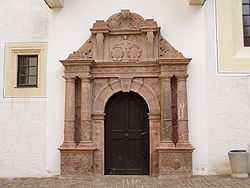Keystone (architecture)


A keystone is the wedge-shaped stone piece at the apex of a masonry vault or arch, which is the final piece placed during construction and locks all the stones into position, allowing the arch to bear weight.[1][2][3] Although a masonry arch or vault cannot be self-supporting until the keystone is placed, the keystone experiences the least stress of any of the voussoirs, due to its position at the apex.[4] Old keystones can decay due to vibration, a condition known as bald arch.
In a rib-vaulted ceiling, keystones may mark the intersections of two or more arched ribs. For aesthetic purposes, the keystone is sometimes larger than the other voussoirs, or embellished with a boss. Mannerist architects of the 16th century often designed arches with enlarged and slightly dropped keystones, as in the "church house" entrance portal at Colditz Castle (see image). Numerous examples are found in the work of Sebastiano Serlio, a 16th-century Italian Mannerist architect.
Figurative use
The term is used figuratively to refer to a central element of a larger structure (such as a theory or an organization) that locks the other elements in place and allows the whole to be self-supporting.[3] Example: Trade is the keystone of modern civilization.
See Keystone (disambiguation) for figurative and other non-architectural uses of the term "keystone".
Gallery
-
.jpg)
The York Minster Chapter House rib-vault ceiling with central and peripheral keystones
-
Ornamental keystone over portal
-

Bossed keystone in the ceiling of an apse chapel (Toulouse Cathedral)
-

Symbolic shape
-

Arches with equal-size voussoirs and keystones, Mosque of Cordoba, Spain
-

The keystone of the gateway to the Venetian arsenal at Gouvia in Corfu carries the inscription "ZBM ANNO MDCCLXXVlll" where "ZBM" are probably the initials of one of the ship captains who constructed the arsenal.
See also
- Architectural sculpture
- Boss (architecture)
- Coping (architecture)
- List of classical architecture terms
- Oculus compression ring
Notes
- ↑ Ching, Francis D.K. (1995). A Visual Dictionary of Architecture. New York: John Wiley & Sons, Inc. p. 12. ISBN 0-471-28451-3.
- ↑ "Glossary of Medieval Art and Architecture – Keystone". University of Pittsburgh. Retrieved 2007-06-25.
- ↑ 3.0 3.1 "keystone". Merriam Webster. Retrieved 2007-06-25.
- ↑ "Windows and More About Arches". Retrieved 2007-06-25.
External links
![]() Media related to keystones at Wikimedia Commons
Media related to keystones at Wikimedia Commons
| Wikisource has the text of the 1911 Encyclopædia Britannica article Keystone. |
_-_Dettaglio_-_Foto_Giovanni_Dall'Orto%2C_31-Aug-2007.jpg)


